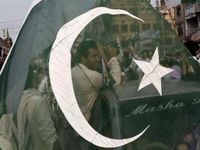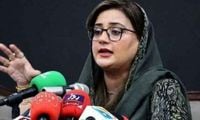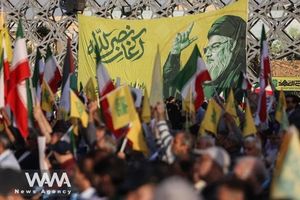In a dramatic turn for South Asia, Pakistan has launched a sweeping crackdown on radical religious groups, formally banning the Tehreek-e-Labbaik Pakistan (TLP) on October 23, 2025, after violent protests erupted across Punjab and other regions. This decisive move, led by the Punjab provincial government and swiftly backed by Islamabad, signals a rare moment of unity in Pakistan’s often fragmented approach to religious militancy.
The chain of events began earlier in October, when the TLP organized what it called a “solidarity march for Gaza.” But as reported by Business Recorder and other outlets, the demonstration quickly spiraled out of control. Protesters blocked major roads, set state property ablaze, and clashed with police—tragically resulting in the deaths of several officers. The violence left many observers wondering about the true intent of the protest. Was it truly about Gaza, or had it become a power struggle—the latest in a series of attempts by the TLP to test the limits of state authority under the banner of faith?
This time, however, the state did not blink. Under the leadership of Chief Minister Maryam Nawaz Sharif, the Punjab government responded with unprecedented force. Thousands of TLP activists were detained, assets were frozen, and the Anti-Terrorism Act was invoked to restrict the group’s leadership. According to Punjab Information and Culture Minister Azma Bokhari, authorities identified 3,600 financial backers of the TLP, both inside Pakistan and abroad. Bokhari also revealed that weapons seized from police by the TLP during a 2021 incident were used again in these latest protests—underscoring the group’s capacity for violence and the risks posed to public safety.
"The writ of the state is supreme and there will be no compromise on the protection of citizens’ lives and property," Bokhari declared, as quoted by Business Recorder. She warned that anyone involved in incitement or violence would be prosecuted under terrorism laws and that illegal weapons must be surrendered immediately. In a further show of resolve, the government suspended 28 arms dealers’ licenses, ordered all unlicensed firearms to be surrendered within a month, and blocked 75 inflammatory social media accounts linked to incitement—arresting 107 people in the process.
Meanwhile, the federal government issued a formal notification outlawing the TLP and its front organizations nationwide. The symbolism of this joint action by Lahore and Islamabad is unmistakable. For decades, Pakistan’s response to religious extremism has oscillated between denial, compromise, and half-hearted bans that were often reversed when politically convenient. The TLP, like many before it, thrived in this ambiguity—mainstreamed when useful, banned when violent, and forgiven when expedient. This cycle, as Dawn notes, now faces its most serious challenge yet.
Yet, as many analysts caution, a ban is not a cure-all. Pakistan has outlawed more than eighty outfits over the past twenty-five years, many of which have re-emerged under new names or guises. The true test, according to commentators in Dawn and elsewhere, lies in whether the courts will sustain the ban, whether prosecutions will hold, and whether the state can disrupt the financial and ideological networks that sustain such groups. The Punjab government’s move to identify thousands of TLP financiers is seen as a critical precedent—but it will require the federal government and judiciary to match that administrative stamina with legal persistence.
While the crackdown in Punjab is aimed at restoring the writ of the state, the situation elsewhere in Pakistan and the region is far more complicated. As reported by India.com and other outlets, the Tehreek-e-Taliban Pakistan (TTP) continues to assert its presence, particularly in the Khyber Pakhtunkhwa province. On October 23, 2025, videos surfaced online showing TTP militants openly patrolling the outskirts of Peshawar, setting up checkpoints on public roads with no visible presence of the army or police. These scenes, which would have been unthinkable just a few years ago, highlight the challenges facing Pakistan’s Army Chief, General Asim Munir, and the limitations of state control in volatile regions.
The TTP, responsible for numerous attacks on Pakistan’s military and security forces—especially in Kashmir and Balochistan—has only grown bolder since the Taliban’s takeover of Afghanistan in 2021. Violence in Khyber Pakhtunkhwa has sharply increased, contradicting earlier assumptions that militancy would decline after the U.S. withdrawal from Afghanistan. The situation has also raised questions about the Doha Agreement between Pakistan and Afghanistan, with Islamabad accusing the Afghan Taliban of sheltering the TTP—a charge Kabul denies, but which has deepened mistrust between the neighbors.
Adding another layer of complexity, Pakistan’s policy toward radical groups appears deeply contradictory on the international stage. As India.com and other Indian sources point out, while Islamabad cracks down on groups like the TLP and TTP at home, it stands accused of supporting Islamist elements in neighboring Bangladesh. Through the ISI and Jamaat-e-Islami, Pakistan is alleged to be pushing for the implementation of strict Sharia law and the creation of an Islamic Revolutionary Army (IRA) in Bangladesh. Reports suggest that over 8,000 individuals are being trained in Bangladesh to form this new force, which would impose stringent Islamic laws and curtail women’s rights—mirroring the Iranian model. The ISI’s alleged involvement in Bangladesh, particularly following the ouster of Sheikh Hasina and the installation of Muhammad Yunus as caretaker, has sparked fears of a broader regional destabilization and deepened suspicions in New Delhi.
The contrast is stark: in Pakistan, radical groups that challenge the state face brutal crackdowns, asset freezes, and mass arrests. In Bangladesh, by contrast, Pakistan is accused of giving a free hand to similar elements to reshape the country’s social fabric. This dual approach has drawn accusations of hypocrisy from analysts and neighboring governments alike, who warn that the rise of Islamist militancy in Bangladesh could soon become a major headache for India and the region at large.
Back in Punjab, the government insists that its crackdown is impartial and comprehensive. Peace committees have been activated across the province, combing operations are underway against illegal Afghan residents, and mobile police stations are being launched to provide swift justice. No mosques have been closed, officials stress, but the use of loudspeakers is now strictly limited to calls to prayer and Friday sermons, with any incitement to be met with legal action. Bokhari warned parents to keep their children away from extremist groups, or risk being named in terrorism cases themselves.
Ultimately, Pakistan stands at a crossroads. The current wave of bans and crackdowns could mark the beginning of a new era—one in which the rule of law prevails over the rule of the mob. But as history has repeatedly shown, the real challenge lies not in the announcement of bans, but in their consistent and impartial enforcement. Only time will tell whether Pakistan can sustain this new resolve, or whether old patterns of compromise and ambiguity will once again reassert themselves.
The coming months will be crucial, not just for Pakistan’s own stability, but for the security and social fabric of the entire region.





